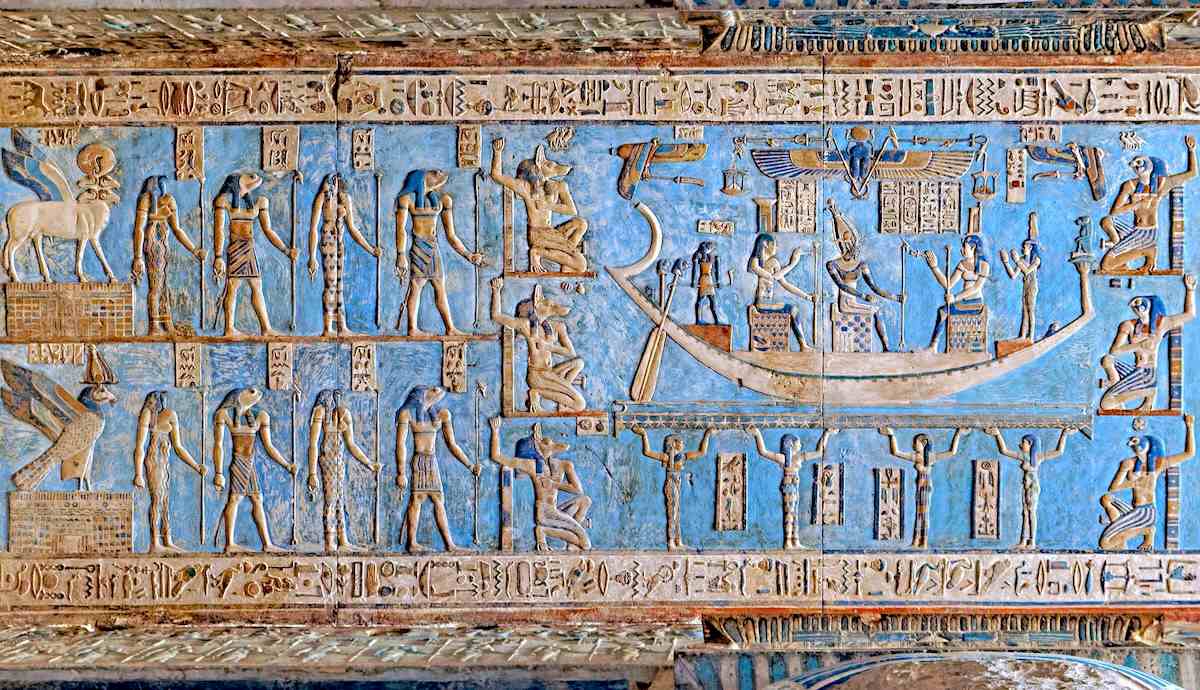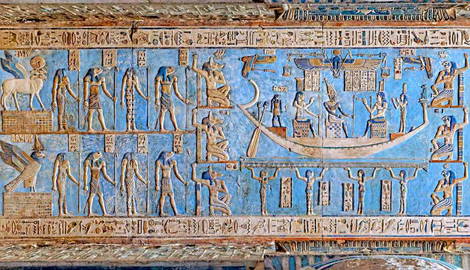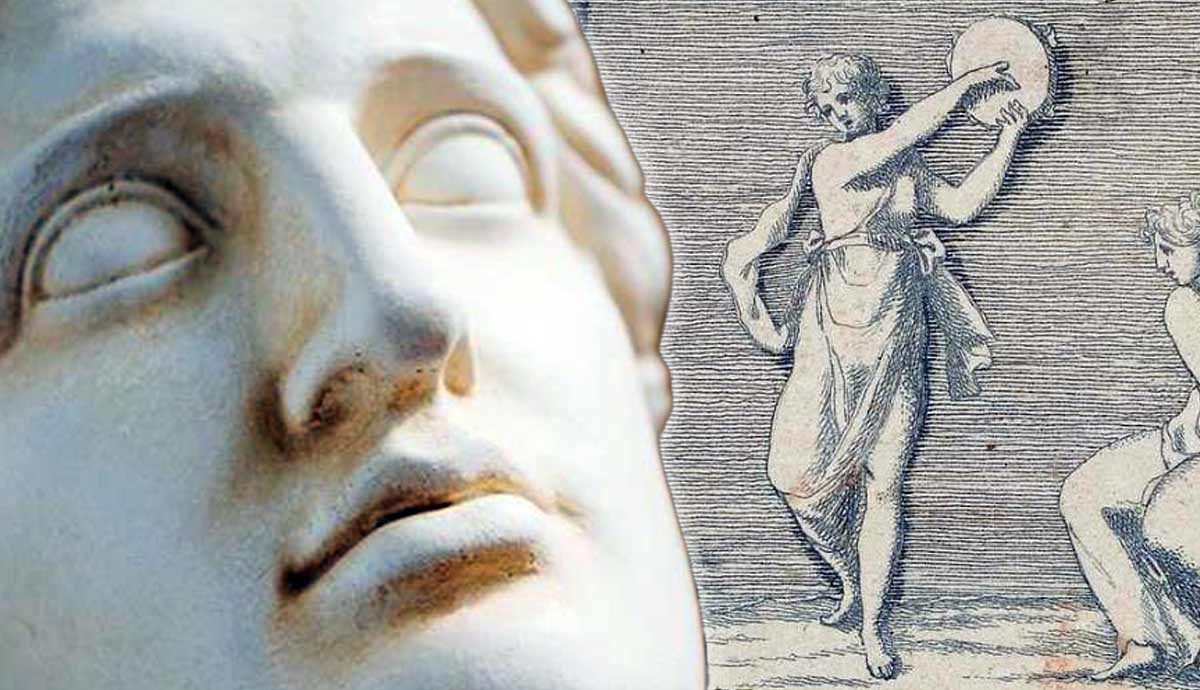
Egyptian blue, the world’s first synthetic pigment, is so much more than just a color. Its incomparable radiance was revered by pharaohs, and its complex chemical properties have long mystified researchers.
Nearly 5,000 years later, it continues to captivate us with its ancient beauty—and its surprising potential in cutting-edge fields such as solar energy, biomedical imaging, and telecommunications. How did an ancient hue become a bright blue beacon of modern-day innovation?
Egyptian Blue: Uses and Symbolism

Egyptian blue is a vibrant and intense blue pigment similar to cerulean or turquoise. In the ancient Egyptian language, Egyptian blue was known as hsbd-iryt, meaning “artificial lapis lazuli.” The color blue held great significance for the ancient Egyptians. However, adding naturally occurring blue pigment to art and ceremonial objects was especially difficult. Semiprecious blue stones, such as lapis lazuli, or minerals like azurite, were neither affordable nor practical. To meet the large demand for the color blue, the Egyptians managed to produce their own artificial version.
Egyptian blue was a hallmark of ancient Egyptian art and culture for thousands of years. The bright blue hue appeared on tombs, murals, statues, jewelry, and ceremonial objects. Symbolically, Egyptian blue was associated with divinity, protection, the heavens, and the Nile River.
Alchemy of the Ancients: The Origins of Egyptian Blue

Egyptian blue was first synthesized around 3300 BCE during Egypt’s Fourth Dynasty. Impressively durable and dazzlingly vibrant, it revolutionized the art of ancient Egypt. Modern-day archaeological finds showcase the pigment’s exceptional quality, which in many cases has endured for thousands of years. Evidence of specialized workshops dedicated solely to the production of Egyptian blue demonstrates the ancients’ sophisticated understanding of chemistry and further highlights the pigment’s profound significance.
Its recipe comprised a precise list of ingredients, including sand or sodium carbonate, calcium, and a copper- or bronze-based mineral. The process also required an extremely hot furnace. Artisans began by mixing the dry ingredients into a flour-like consistency. Then, they rolled the mixture into small balls, which they placed into a furnace heated to about 1,800 degrees Fahrenheit (1,000 degrees Celsius). The heat caused the mixture to solidify into a glassy blue lump, or frit, that could be ground into a pigment.
Beyond the Nile: From the Romans to the Renaissance

Because Egyptian blue was beloved by the ancients for centuries, it inevitably spread beyond Egypt’s borders. Traces of the pigment have been found throughout the ancient Mediterranean. The Romans, for example, adapted Egyptian blue for use in their mosaics and fresco paintings. The pigment was produced and traded throughout the Roman Empire as an affordable alternative to indigo, which had to be imported from afar. Small caches of unused pigment have been found in the tombs of Roman artists, as well as in the ruins of Pompeii.
By the Middle Ages, the use of Egyptian blue had almost entirely ceased. This was likely due to the loss of its production technique. However, when Renaissance artists began studying and emulating Greco-Roman art, Egyptian blue experienced a brief resurgence. The pigment has since been identified in notable Italian Renaissance artworks, such as Giovanni Battista Benvenuto’s 1521 painting, St. Margaret, and Raphael’s 1512 fresco, The Triumph of Galatea.
Rediscovering the Lost-Lost Hue of the Pharaohs

The secrets of Egyptian blue were eventually lost to the sands of time, but its curious optical effects and potential scientific applications never ceased to intrigue scientists. In the 19th century, chemical analyses began to shed light on the long-lost process of synthesizing Egyptian blue. Now, in partnership with the Smithsonian’s Museum Conservation Institute and the Carnegie Museum of Natural History, scientists at Washington State University have successfully replicated the complex composition of Egyptian blue.
For the first time since ancient Egypt, the multidisciplinary research team developed 12 recipes for Egyptian blue using varying combinations of silicon dioxide, copper, calcium, and sodium carbonate. To mimic the conditions likely used by ancient artisans, each mixture was heated at around 1,800 degrees Fahrenheit (1,000 degrees Celsius) for up to 11 hours. The results will allow the full scope of Egyptian blue’s potential to be explored by scientists and historians alike.
The Scientific Secrets of Egyptian Blue

Beyond its aesthetic value, it turns out that Egyptian blue has a wide range of practical applications in today’s world. For example, the ability to detect and map the pigment enables art historians and conservators to gain a deeper understanding of the history and evolution of ancient art practices. This capability can also help reconstruct lost decorative patterns that were painted with pigment and inform the development of more effective art preservation strategies.
Due to its unique composition, Egyptian blue does not react to the presence of other pigments, nor does it suffer significant damage from prolonged exposure to light. Nanoscale analysis has revealed that the pigment is luminescent under infrared light. In the realms of solar energy technology, telecommunications, biomedical imaging, and many other fields, the technological advancements this phenomenon alone could enable are unprecedented.
From adorning ancient temples to advancing scientific frontiers, Egyptian blue exemplifies human creativity and innovation. Its journey through time highlights the enduring power of both art and science to shape our understanding of the world.











